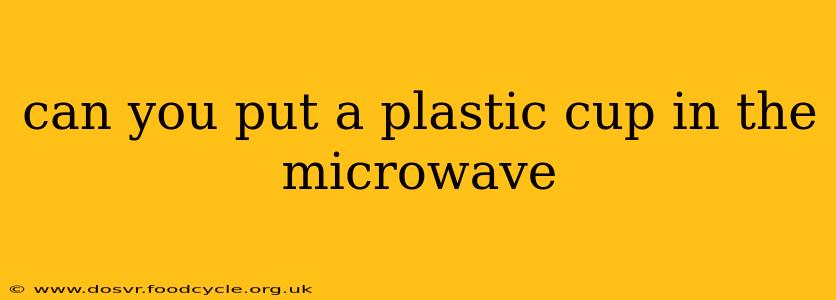Can You Put a Plastic Cup in the Microwave? A Comprehensive Guide
The simple answer to "Can you put a plastic cup in the microwave?" is: it depends. Not all plastic cups are microwave-safe, and using the wrong type can lead to melting, warping, or even releasing harmful chemicals into your food. This guide will help you understand which plastics are safe and how to identify them.
What Makes Some Plastics Microwave-Safe?
The key lies in the type of plastic. Microwave-safe plastics are specifically designed to withstand the high temperatures and frequencies used in microwaving without leaching chemicals or altering their shape. These plastics are typically more heat-resistant and have a molecular structure that doesn't break down under microwave radiation.
How Can I Tell If My Plastic Cup Is Microwave-Safe?
Look for the recycling symbol (usually a triangle with a number inside) on the bottom of the cup. The number inside the triangle indicates the type of plastic. The most important number to look for is 5 (PP) or Polypropylene. This plastic is generally considered microwave-safe, though it's always best to check the manufacturer's instructions.
Other numbers, such as 1 (PET or PETE), 2 (HDPE), 3 (PVC), 4 (LDPE), 6 (PS), and 7 (Other), are usually not recommended for microwave use. These plastics may melt, warp, or release harmful substances when heated.
What Happens If I Microwave a Non-Microwave-Safe Plastic Cup?
Using a non-microwave-safe plastic cup in the microwave could result in several undesirable outcomes:
- Melting: The plastic may begin to melt, potentially ruining your food and the cup itself.
- Warping: The cup may become misshapen and unusable.
- Chemical Leaching: Harmful chemicals from the plastic could leach into your food, posing a health risk.
- Fire Hazard: In extreme cases, the plastic could even ignite.
Are All Plastic Cups Labeled Correctly?
Unfortunately, not all plastic cups are clearly labeled. Some manufacturers may omit the recycling symbol or provide unclear instructions. When in doubt, it's always best to err on the side of caution and avoid microwaving the cup.
What Are Some Alternatives to Using Plastic Cups in the Microwave?
If you're unsure about your plastic cup's microwave safety, consider these alternatives:
- Microwave-safe glass or ceramic mugs: These are excellent choices, as they're both durable and heat-resistant.
- Microwave-safe plastic containers: Look for containers specifically labeled as microwave-safe, paying attention to the recycling symbol and manufacturer's instructions.
Are there specific types of polypropylene cups that aren't microwave safe?
While polypropylene (PP) is generally considered microwave-safe, the quality and specific additives in the plastic can vary between manufacturers. Some polypropylene cups may not be as heat-resistant as others. Always check the manufacturer’s instructions for specific guidelines.
Can I microwave a plastic cup if it's only for a short time?
Even short periods of microwave heating can still pose risks with non-microwave-safe plastics. The safest approach is to avoid microwaving any plastic cups that aren't specifically labeled as microwave-safe, regardless of the heating time.
In conclusion, while some plastic cups are microwave-safe, it's crucial to check the recycling symbol and manufacturer's instructions before placing any plastic cup in the microwave. Using a microwave-safe alternative is always the safest option.
